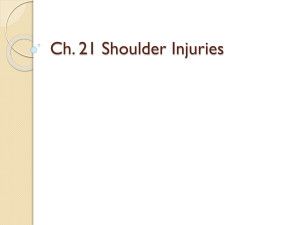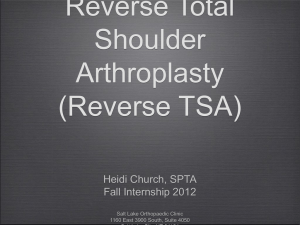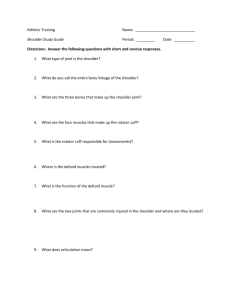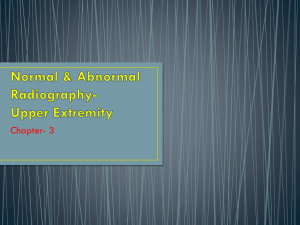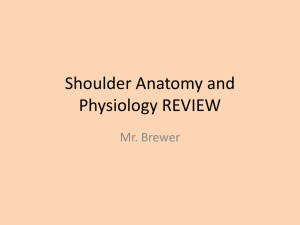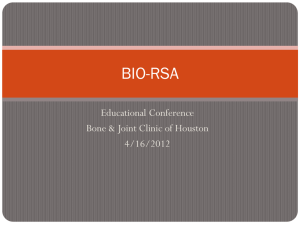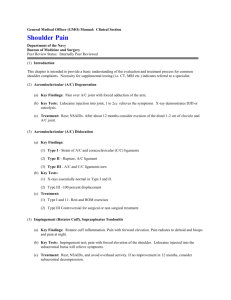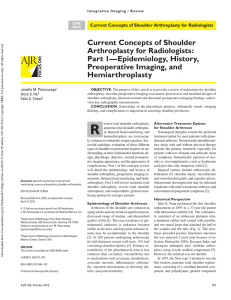Shoulder Arthroplasty
advertisement
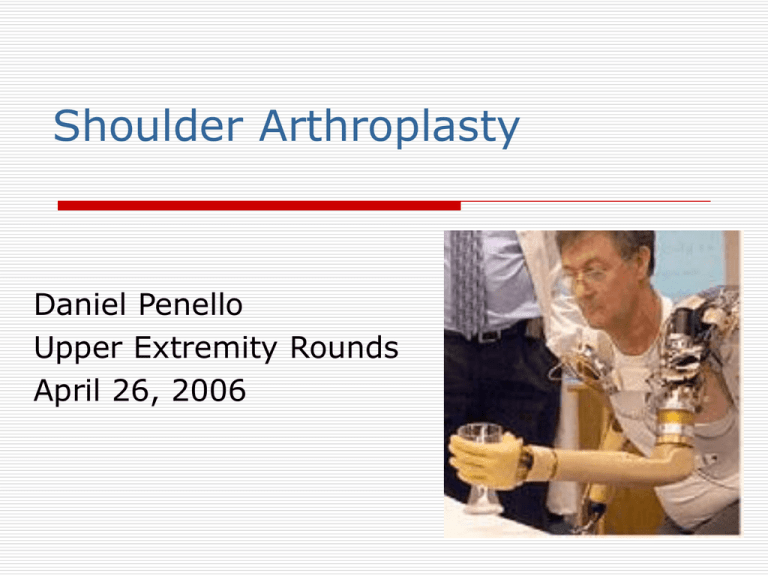
Shoulder Arthroplasty Daniel Penello Upper Extremity Rounds April 26, 2006 Lesions of the shoulder requiring arthroplasty are much less common than lesions involving the weightbearing joints of the body, such as the hip and knee. The Shoulder Greatest ROM No inherent bony stability Relies on soft tissues for stability Many injuries involve the soft tissues (rotator cuff, labrum) Little glenoid bone stock Indications for Shoulder Arthroplasty Osteoarthritis Rheumatoid arthritis Rotator cuff tear arthropathy Avascular necrosis Post-traumatic arthritis Severe proximal humeral fractures Arthroplasty Options Hemiarthroplasty Reverse Total Shoulder Total Shoulder Surgical Approach Deltopectoral Coracoid A little history 1893- French surgeon Pean inserted platinum and rubber components to replace a shoulder joint destroyed by tuberculosis. 1951- Neer I, Vitallium Hemiarthroplasty prosthesis which resulted in pain relief and good function compared to previous options. 1974- Neer II Prosthesis. Modified Neer I to conform to a glenoid component. Courtesy of Smith & Nephew 1970’s - constrained components were popular, but follow-up reports demonstrated high rates of loosening, particularly of the glenoid component. 1980’s – Modular humeral components were developed, along with cementless glenoid fixation using polyethylene on a metal backing. Cemented polyethylene versus uncemented metalbacked glenoid components in total shoulder arthroplasty: a prospective, double-blind, randomized study. Boileau P, Avidor C, J Shoulder Elbow Surg. 2002 Jul- Aug;11(4):351-9. 40 Shoulders with 3 year follow up. Metal-backed – 2% radiolucent lines, 100% progressive, 25% loose in 3 years. Associated with shift and osteolysis. Cemented – 80% radiolucent lines, 25% progressive. None loose in 3 years. Other Problems with Metal-Backed Glenoid Components Metal-backing increased the thickness of the component and often lead to overstuffing of the joint. To avoid over-stuffing the joint, the polyethylene thickness had to be reduced, resulting in accelerated poly wear & failure Poly-metal disassociation occurred with unacceptable frequency. Humeral Components CEMENTED PROX POROUS COATED FULLY POROUS COATED Good for osteopenic bone Need good bone stock Need good bone stock Lower risk of intra-operative fracture Higher risk of intra-operative fracture Higher risk intra-operative fracture More stress More stressshielding Less stressshielding Hard to revise Easier to revise shielding Hard to revise Cemented vs Press-fit Humeral Components Harris, Jobe and Dai reported less micromotion with proximally-cemented stems. Fully cemented stems provide no additional benefit or stability over proximallycemented stems. Sanchez-Sotelo reported a low rate of stem loosening regardless of fixation, but pressfit prostheses developed more radiolucent lines in the first 4 years. The Need for Modularity F-H Offset B-C Head thickness D-E = 8mm Top of humeral head is higher than greater tuberosity The Need for Modularity Reestablishing normal glenohumeral anatomic relationships is important to ensure optimal results. Iannotti JP; JBJS 74A 1992 Other Anatomic Variables to Consider Glenoid : 2° anteversion 7° retroversion to Humeral Head: 20° - 40° retroversion Axial CT of the glenohumeral joint is a valuable pre-op planning tool. Contraindications to Shoulder Arthroplasty Active or recent shoulder joint infection Paralysis with complete loss of rotator cuff and deltoid function A neuropathic arthropathy Irreparable rotator cuff tear is a contraindication to glenoid resurfacing. Osteoarthritis In addition to the universal features of osteoarthritic joints (joint space narrowing, cyts, osteophytes…), the shoulder can also demonstrate Posterior glenoid erosion Flattening of the humeral head Enlargement of the humeral head Rotator cuff tears are uncommon in OA Hemi vs Total Shoulder Easy procedure Short Operating time Less risk of instability Can be revised to TSA More consistent pain relief Better fulcrum for active motion Less reliable pain relief Progressive Glenoid erosion may cause results to deteriorate over time Need concentric glenoid Difficult procedure Longer OR time Poly wear can cause loosening of both components More Glenoid bone loss Recommendation based on Experience Neer, 1998 “When the articular surface of the glenoid is good, the results of hemiarthroplasty are similar to those of TSA. Wear on the glenoid has not been a problem if the articular surface was good at the time of surgery and glenohumeral motion was re-established” Recommendations based on Evidence Kirkley et al, 2000 42 pts, 3 surgeons (stratified) One year follow-up No significant difference in WOSI, ASES, DASH Constant Score or ROM. Trend towards better pain relief with TSA. 2 Hemi patients crossed over to TSA after 1 year follow-up. Recommendations based on Evidence Gartsman, 2000 51 shoulders Average f/u of 35 months No difference in ASES or UCLA scores. Significantly better pain relief with TSA 3 pts crossed over to TSA by 35 months A comparison of pain, strength, range of motion, and functional outcomes after hemiarthroplasty and total shoulder arthroplasty in patients with osteoarthritis of the shoulder. A systematic review and meta-analysis. Bryant D, Litchfield R; J Bone Joint Surg Am. 2005 Sep;87(9):1947-56. Included 4 RCT’s Average 2 year follow-up. TSA resulted in significantly improved UCLA scores, pain relief and increased forward elevation (by 13°). This meta-analysis concluded that at 2 years of follow-p, TSA provided a better functional outcome, however the problems of glenoid component loosening in the TSA group and progressive glenoid erosion in the hemi group may affect the eventual long-term outcome. Longer follow-up is necessary Recommendations based on Evidence The results of arthroplasty in osteoarthritis of the shoulder. Haines JF et al. J Bone Joint Surg Br. 2006 Apr;88(4):496-501 Prospective study of 124 shoulder arthroplasties for OA (Hemi and TSA) Similar improvement in pain and function in both groups if rotator cuff was intact . Better results with Hemi if + rotator cuff tear Hemi Revision at mean of 1.5 years for glenoid pain TSA Revision at mean of 4.5 years for glenoid loosening Technical Issues to Consider OA tends to result in posterior glenoid wear/erosion, which, if accepted, will lead to a retroverted glenoid component. Compensate by anterior reaming or placing the humeral component in LESS retroversion. Failure to do so will result in Posterior Instability Rheumatoid Arthritis Peri-articular erosions Peri-articular osteopenia Thin cortices Adjacent joint involvement Rheumatoid Arthritis Cemented short-stemmed prosthesis Gill, Cofield et al recommend at least 60mm between the cement mantles of ipsilateral shoulder and elbow arthroplasties. If this cannot be achieved, join both cement mantles together. Rheumatoid Arthritis Generally, TSA performed due to destruction of the glenoid articular surface by the disease. Glenoid erosion may require bone grafting, however, if glenoid is eroded to the level of the coracoid process, glenoid resurfacing is contraindicated Rotator Cuff Arthropathy Described by Neer, Craig and Fukada in 1983. A distinct form of osteoarthritis associated with a massive chronic rotator cuff tear. Generally, rotator cuff tears occur in less than 10% of shoulders with OA Rotator Cuff Arthropathy A function of the rotator cuff is to depress the humeral head and keep it centered on the glenoid fossa. Massive rotator cuff tears result in proximal migration of the humeral head. This is a contraindication to glenoid resurfacing as it results in eccentric (superior) glenoid loading and early component loosening. Surgical Options Hemiarthroplasty with a large head Repair of rotator cuff and TSA Reverse TSA “Clayton Spacer” Outcomes of Hemiarthroplasty Rockwood: 86% satisfactory results after 4 years Zuckerman: 93% adequate pain relief and 90% had improved function for ADL’s. Sanches-Sotelo: 75% modest improvements in ROM and strength for ADL’s. Good pain relief. Outcomes of Hemiarthroplasty Field et al, and Sanchez-Sotelo reported that impaired deltoid function and previous subacromial decompression (loss of coracoacromial ligament) were significantly associated with clinical shoulder instability post hemiarthroplasty. Reverse Total Shoulder Arthroplasty Lateralizes the centre of rotation and places the deltoid at a mechanical advantage. More inherent stability and prevents proximal migration of humeral head. Outcomes of the Reverse Total Shoulder The Reverse Shoulder Prosthesis for glenohumeral arthritis associated with severe rotator cuff deficiency. A minimum twoyear follow-up study of sixty patients. Frankle M, Siegel S, J Bone Joint Surg Am. 2005 Aug;87(8):1697-705 Average age = 70 Improved ASES scores Improved ROM Flex: Abd: 55 105° 41 102° 17% Complication rate 7 failures 5 revised to new Reverse TSA 2 revised to Hemiarthroplasties Outcomes of the Reverse TSA (Delta III prosthesis) Treatment of painful pseudoparesis due to irreparable rotator cuff dysfunction with the Delta III reverse-balland-socket total shoulder prosthesis. Werner CM, Glbart M, J Bone Joint Surg Am. 2005 Jul;87(7):1476-86. 58 consecutive patients, average age = 68 41 cases were revisions Follow up = 38 months Improved Constant Score, Pain reduction and improved ROM. ROM: Flex: 42 100° Abd: 43 90° 50% complication rate (including minor) If a 1° surgery = 18% re-operation rate If a Revision surgery= 39% re-operation rate Reverse Total Shoulder Arthroplasty is Hard to Revise Little Glenoid bone stock once component is removed. Osteonecrosis Causes: Corticosteroids Alcoholism Sickle cell diesese Lupus Idiopathic Osteonecrosis Usually young patients with adequate bone stock. Prefer proximally porous-coated, press-fit humeral prosthesis. less stress-shielding easier to revise if necessary Only resurface glenoid in stage V osteonecrosis (glenoid erosion). Post-Traumatic Arthritis Due to fractures treated conservatively May have mal-union of tuberosities, distorting normal anatomic landmarks 12% of patients have axillary nerve palsies (Neer). Many have soft-tissue contractures and muscle weakness Choice of Prosthesis Consider Patient age Condition of glenoid surface and bone stock Axillary nerve palsy is a relative contraindication to arthroplasty Complications Instability 1.2% Excessive Retro/Anteversion Head too small Head too low (post fracture) Subscap rupture Complications Rotator Cuff Tear 2% Results in superior migration of humerus and glenoid loosening Glenoid loosening Complications Infection 0.5% Staph Aureus More common after revision surgery Complications Heterotopic Ossification 10 -45% Males Dx = osteoarthitis Low grade Non-progressive Does not affect outcome Sperling, Cofield et al Complications Stiffness Depends on indication for arthroplasty Subscap shortening Oversized components Inappropriate rehab Complications Periprosthetic Fracture Intra-op 1% Post-op 0.5 - 2% Most common in RA 85% women Glenoid fractures are rare Complications Axillary nerve injury Rare Higher risk during revision surgery Usually a neuropraxia Ultimate Bail -Outs Excision Arthroplasty Shoulder Arthrodesis Thank You
